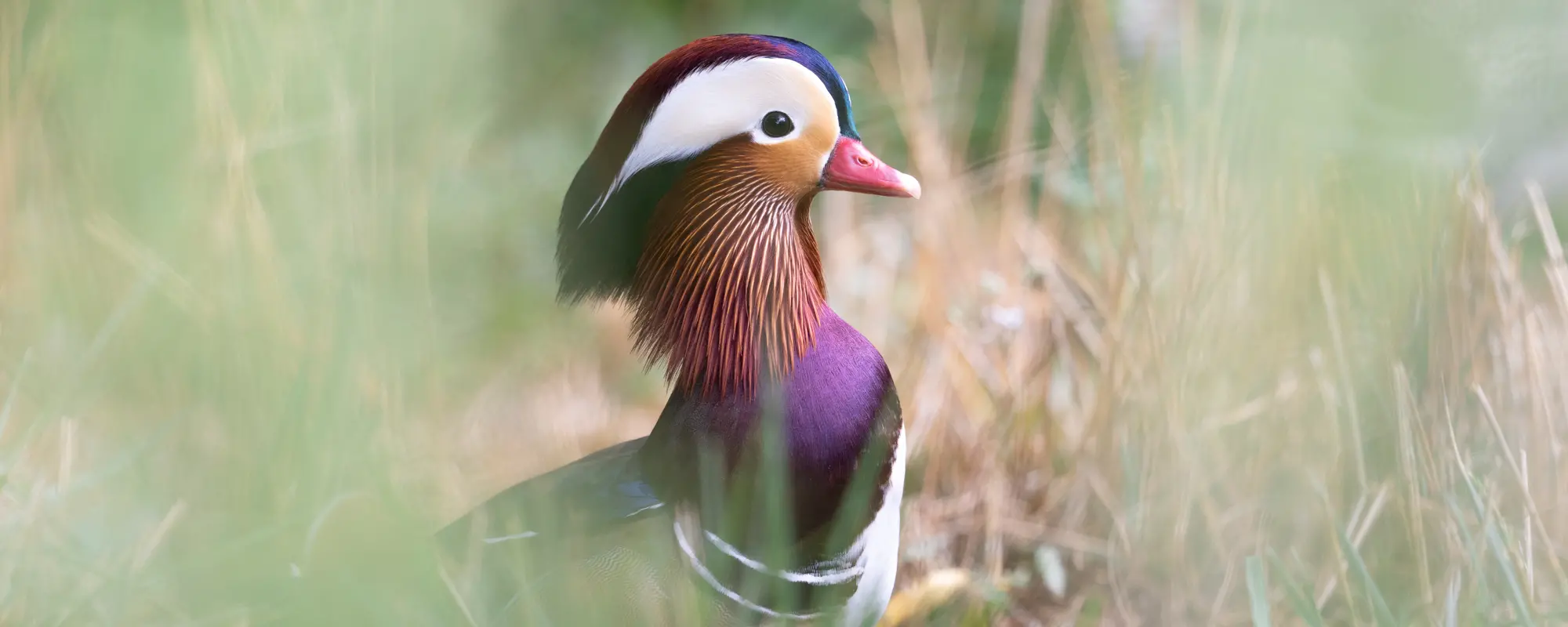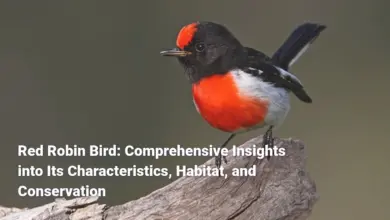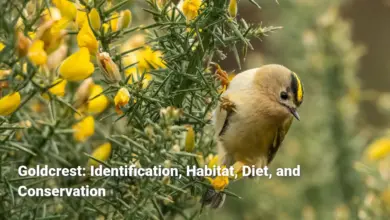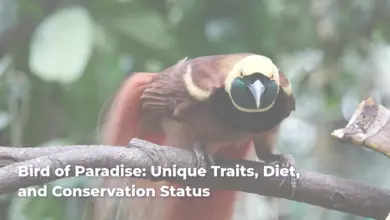Mandarin Duck: A Guide to the Vibrant Species
Exploring the Stunning Beauty, Habits, and Cultural Significance of the Mandarin Duck
The Mandarin duck (Aix galericulata) is more than just a visually stunning species; it symbolizes courtship, fidelity, and beauty in various cultures worldwide. Frequently touted as one of the most picturesque waterfowl, the male Mandarin duck boasts an extraordinary palette of colors, making it a favorite subject for photographers and nature lovers alike. The duck is not only captivating in appearance but also embodies significant cultural and symbolic meanings, particularly in East Asia, where it is often associated with love and unwavering partnership. Its graceful movements, striking plumage, and intriguing behavior make it a subject of fascination for both enthusiasts and scholars.

As we delve into the multifaceted life of the Mandarin duck, we will explore their physical characteristics, habitat preferences, feeding behaviors, breeding rituals, and the cultural significance that these remarkable birds hold across various societies. From their vibrant coloration to their complex nesting behaviors, Mandarin ducks not only enrich our natural environment but also resonate deeply within cultural narratives, providing insights into human relationships intertwined with the natural world. Join us on this exploration of an avian species that beautifully illustrates the harmony between nature and culture.
Characteristics of Mandarin Duck
Mandarin ducks are undeniably remarkable creatures, characterized by their distinct physical attributes, vibrant coloring, and interesting behaviors. In the avian world, they are often referred to as the “royalty of ducks” due to their extravagant plumage, which stands out vividly against the backdrop of lakes and wetlands. In comparison to other waterfowl, male Mandarin ducks display a kaleidoscope of colors, akin to a colorful tapestry woven with intricate patterns. The juxtaposition between the males and females highlights the concept of sexual dimorphism, where the males flaunt bright colors primarily for mating displays, while females don a more muted palette like the earthy tones of autumn to ensure their safety during nesting.
Summary of Characteristics
| Feature | Males | Females |
|---|---|---|
| Plumage | Vivid colors (red, green, blue) | Mottled brown and gray |
| Size | 16-19 inches | Slightly smaller |
| Weight | 430-690 grams | 430-800 grams |
| Nesting Preference | Tree cavities | Tree cavities, high altitude |
| Vocalization | Soft chirps | Quieter sounds |
Overall, the allure of the Mandarin duck lies not only in its physical beauty but also in its distinct behaviors and societal roles within their ecosystems. Whether seen gliding gracefully across the water or perched majestically on a branch, these ducks leave a lasting impact on all who encounter them.
Description of Physical Attributes
The physical attributes of Mandarin ducks are a testimony to nature’s artistry. Males are undeniably the stars of the show, flaunting an elaborate display of colors that resemble a painter’s dream palette. Generally, they are about 16 to 19 inches in length, with a wingspan that extends to approximately 26.7 to 29.1 inches, making them capable of agile flight across various landscapes. The male’s plumage, as diverse as a richly embroidered tapestry, showcases colors ranging from vibrant reds and greens to delicate pastels, reminiscent of a sunset reflecting on a serene lake.
In stark contrast, females possess a more understated elegance. Their plumage comes in muted shades of gray and brown, with splashes of white that create a stunning camouflage. This ability to blend into their surroundings plays a critical role in their survival, especially during nesting when they need to avoid predators. Both sexes exhibit a beautiful symmetry, decorated with striking features such as the male’s characteristic “sails” of feathers that rise above its back, akin to a regal crown.
Unique Coloration Patterns
The unique coloration patterns of Mandarin ducks present a striking visual treat, representing one of the most vivid displays of avian diversity. In males, the iridescent green head glimmers like a jewel in sunlight, while peach and orange shades accentuate the body. Purple hues on the chest create a stunning contrast, making for a breathtaking visual spectacle when seen up close. This resplendent set of colors positions the male as a beacon of health and vitality, essential traits for attracting a mate.
In contrast, female Mandarin ducks exhibit a more subdued yet equally beautiful coloration. Their mottled brown feathers provide impeccable camouflage among the reeds and grass, blending seamlessly into their surroundings. The delicate white eye-ring and hints of red near the beak lend a touch of charm to their appearance, ensuring they remain both visually appealing and strategically hidden. This brilliant contrast in coloration not only reflects their respective evolutionary roles but also showcases the diversity of the species as a whole.
Sexual Dimorphism in Mandarin Duck
Sexual dimorphism is profoundly illustrated in Mandarin ducks, wherein males and females display contrasting physical attributes that correlate to their behaviors within the breeding season. Males, adorned with flamboyant hues and elaborate feather patterns, engage in energetic courtship displays designed to attract females. These displays often involve a series of intricate movements and vocalizations, each serving to communicate their genetic fitness and readiness to mate.

Females, conversely, embody a more practical aesthetic. Their muted coloration enhances their ability to remain inconspicuous, allowing them to evade predators while incubating eggs. While males may contend for the attention of females through flashy displays, females often exercise discretion and choice, opting for mates that exhibit the most striking coloration and confidence during courtship rituals.
Such a vivid divergence in appearance serves both functional and social purposes, illustrating the intricacies of evolutionary adaptation where beauty intertwines with utility. Understanding the nuances of these physical characteristics deepens our appreciation for the Mandarin duck as a species rich in complexity and cultural significance.
Habitat and Distribution of the Mandarin Duck
Mandarin ducks are fundamentally tied to specific aquatic ecosystems, primarily inhabiting areas that offer abundant resources for feeding and nesting. Linked to freshwater ecosystems, these ducks thrive in a range of habitats, including rivers, lakes, and wetlands. Like actors in a well-rehearsed play, they take the stage wherever they find suitable environment to flourish. These habitats provide not only essential sustenance but also shelter from predators, allowing these ducks to thrive in both natural and urban locales.
Summary of Habitat Preferences
| Habitat Type | Preferred Features |
|---|---|
| Riparian areas | Proximity to water with shrub vegetation |
| Urban environments | Parks and gardens with water bodies |
| Coastal lagoons & wetlands | Diverse aquatic resources |
The adaptability of Mandarin ducks showcases their resilience, as they can thrive in various environments ranging from lush forests to urban parks, underscoring the need for conservation efforts that protect their habitats against encroaching development.
Preferred Habitats
Mandarin ducks prefer wetter environments that provide both cover and resources for feeding. They are often found in riparian habitats, where rivers and streams meet lush vegetation, providing vital nesting arboreal spaces high above the ground. The ducks tend to nest in tree cavities or even in artificial nest boxes, taking advantage of the elevation to keep their young safe from ground predators.
The mix of habitats they inhabit varies seasonally. During the breeding season, Mandarin ducks seek out calm waters lined with shrubbery for nesting, which serves to conceal them and protect their nests from predators . High-altitude environments, such as temperate forests, where they can forage for seeds and nuts, are also favored. In winter months, their migratory patterns lead them to coastal lagoons and rice paddies, showcasing their ability to adapt to varying ecosystems throughout the seasons.
Geographic Range
Mandarin ducks have an expansive geographic range primarily situated in East Asia. Their native habitats extend from southeastern Russia through northern China, Japan, South Korea, and North Korea. During the breeding season, these ducks nest in the colder northern regions, including Siberia and parts of eastern China. Their migratory behavior reveals a fascinating journey as they travel southward to wintering grounds in southern China and Japan, seeking a more temperate climate to endure the cold months.
Non-natively, Mandarin ducks have also made their mark outside their traditional habitats. The ducks have established populations in various parts of Europe and North America due to human introductions. In England, Germany, and areas of the western United States, these ducks have adapted to local environments, leading to thriving feral populations.
Migration Patterns of the Mandarin Duck
The migration patterns of Mandarin ducks are intricately tied to the changing seasons, showcasing their adaptability to varying environments. As full migratory birds, they embark on annual journeys between their breeding and wintering grounds in search of suitable habitats. Typically, migration begins in late summer or early fall, with ducks traveling significant distances to locate water bodies that can sustain them during the colder months.
During the breeding season, pairs often separate from their social flocks to find nesting sites, where they can lay eggs and raise their young in relative safety. Once the ducklings hatch, they engage in a remarkable behavior characterized by leaping from high nests to the ground below. This instinctual act reflects their adaptation to navigate various habitats seamlessly.
Moreover, Mandarin ducks have honed their migratory instincts, adeptly using features in the landscape and weather patterns to guide their travels. Observations indicate that these birds prefer to fly at low altitudes, often making short breaks to rest and forage, underscoring their resilience and adaptability to their environment.
Diet and Feeding Behavior of the Mandarin Duck
Mandarin ducks are omnivorous and display an impressive range of dietary preferences that pivot according to seasonal availability. Their diet includes an assortment of plant materials, insects, and small aquatic organisms, revealing their adaptable feeding behaviors. Utilizing both in-water and terrestrial foraging techniques, they are adept at navigating their environments to find suitable nourishment.

Summary of Dietary Preferences
| Seasonal Diet Composition | Examples of Food Sources |
|---|---|
| Spring/Summer | Aquatic insects, small fish, and seeds |
| Fall/Winter | Grains, nuts, and plant material (e.g., water lilies) |
This adaptability not only ensures that Mandarin ducks can meet their dietary needs across various seasons but also contributes to their role as essential players in local ecosystems, particularly in seed dispersal.
Typical Diet in the Wild
In the wild, Mandarin ducks feast on an extensive diet that is influenced by seasonal changes. During warmer months, they actively seek out animal proteins, including insects and small fish, essential for providing the necessary nutrients for breeding. However, as temperatures drop, their diet shifts substantially, leaning towards plant-based nutrition. In these colder months, they may rely heavily on grains, seeds, and other vegetation, consuming aquatic plants that offer sustenance during lean times.
Feeding behavior varies according to the time of day, with ducks displaying heightened activity during early morning and late evening. The flexibility in their diet and behaviors allows for efficient foraging and demonstrates their resilience in adapting to changes in their environment.
Foraging Techniques
When searching for food, Mandarin ducks utilize impressive foraging techniques that showcase their adaptability. They are known to dabble on the water’s surface, filter feeding as they swim, or foraging along riverbanks for seeds and plants. A dominant strategy employed by these ducks is “up-ending,” wherein they tilt their bodies forward in the water to reach submerged food. This technique allows them to access a broader range of aquatic plants and invertebrates that may be out of reach in a more vertical position.
Mandarin ducks’ remarkable agility enables them to walk and forage on land as well, making them versatile foragers. Their ability to vary their feeding strategies depending on environmental conditions reflects their adaptability to dynamic habitats a crucial characteristic for their survival in the wild.
Impact of Diet on Health
The diet of Mandarin ducks is closely intertwined with their overall health, making it crucial to ensure they have access to a rich variety of natural food sources. Studies indicate that the composition of their diet significantly influences their gut microbiota, which, in turn, impacts their digestion, immunity, and general well-being. When Mandarin ducks consume diets that deviate from their natural feeding behaviors, such as in captive settings, they may experience health challenges.
For instance, a diet heavy in unnatural food sources can disrupt their gut microbial communities, leading to issues such as dysbiosis an imbalance that may compromise their health and longevity. This relationship between diet and gut health is a vital consideration for conservationists, especially in captive breeding programs where the goal is to maintain healthy, thriving populations.
Breeding and Reproduction of the Mandarin Duck
Mandarin ducks exhibit captivating breeding and reproductive behaviors marked by complex rituals that aid in mate selection and the establishment of strong pair bonds. Typically monogamous, they often form lasting partnerships, which may span several breeding seasons. Each courtship is a performance that showcases the dazzling attributes of the males, while the females assess their suitability as potential partners.
Summary of Breeding Behaviors
| Breeding Aspect | Description |
|---|---|
| Mating Rituals | Elaborate displays involving mock drinking |
| Nesting Preferences | High tree cavities, 9-12 eggs per clutch |
| Parental Responsibilities | Females incubate and care for ducklings; males often leave post-nesting |
The breeding behaviors of Mandarin ducks highlight the intricate dance of attraction and commitment that defines their unique species, further enriching both their ecological role and cultural significance.
Mating Rituals
Males engage in striking courtship displays to capture the attention of females. Much like an elaborate dance, these displays include a mix of mock drinking, head bobs, and feather displays, presenting the male’s dazzling plumage in full view. These vibrant exhibitions act as a visual narrative, allowing females to assess a male’s fitness, health, and genetic quality. The ritualistic nature of these acts mirrors the deeper connection between beauty and survival in the animal kingdom.
Moreover, these vibrant displays happen in tandem with vocalizations, often made to indicate their excitement or establish territory. The effectiveness of these courtship strategies plays a crucial role in ensuring the continuation of their genetic lineage, as successful males attract enduring bonds with receptive females.
Nesting Habits
Once mating has occurred, nesting duties primarily fall to the female, who instinctively searches for high tree cavities to construct her nest a unique aspect of their reproductive strategy. These elevated nesting sites, often as high as 30 feet off the ground, offer enhanced protection from terrestrial predators while also affording easy access to nearby water sources for their eventual ducklings. She lays 9 to 12 eggs, which she diligently incubates for a period of 28 to 30 days.
Upon hatching, the ducklings rely on ancient instincts, performing a remarkable leap from the nest to the ground below. This instinctual behavior showcases their resilience and readiness to face the challenges ahead, as they are keened to follow their mother to water and food shortly after birth.
Lifecycle of Mandarin Duck
The lifecycle of the Mandarin duck transitions through various stages, each rich with complexities that illustrate survival and adaptation. After courtship and successful nesting, the next chapter unfolds as the newly hatched ducklings emerge into the world. These precocial younglings can swim and feed themselves almost immediately, preparing them for the independence they will need to thrive in the wild.
The lifecycle continues as the ducklings grow, molting into adult plumage over several weeks. By the time they reach 40 to 45 days post-hatching, they typically fledge, gaining the ability to fly and navigate their environment adeptly. As fledglings, they begin to integrate into social flocks, showcasing behaviors learned from their mothers, while establishing their places within the intricate dynamics of duck society.
With time, these ducks mature, engaging in their own courtship rituals, thus perpetuating the fascinating cycle of life that connects each generation to the next each story entwined through shared habitat, instinct, and the indelible beauty of the Mandarin duck.
Cultural Significance and Symbolism of the Mandarin Duck
Mandarin ducks have garnered immense cultural significance, particularly in East Asian traditions, as symbols of love, fidelity, and marital bliss. Their deep-seated role in folklore and artistic representations captures the essence of romantic relationships and loyalty, reflecting the unique bond these birds form in their courtship and family life.
Summary of Cultural Symbolism
| Symbolism | Description |
|---|---|
| Love and Fidelity | Represent marital harmony and enduring love |
| Role in Art | Commonly depicted in paintings and sculptures |
| Folklore | Associated with legends promoting loyalty and love |
Through their transcendent symbolism and roles in cultural narratives, Mandarin ducks continue to captivate the imagination and hearts of many across different societies.
Role in Art and Literature
Mandarin ducks are celebrated in various forms of art and literature, revered for their exquisite beauty and the potent meanings they symbolize. Frequently featured in traditional Chinese paintings, these birds are often depicted alongside lotus flowers another representation of purity and affection. This artistic pairing enhances their significance as emblems of enduring love and harmony.
In literature, Mandarin ducks are not merely characters but narrative devices that encapsulate themes of fidelity often discussed in romantic contexts. One notable example is a traditional story where the sighting of a pair prompts reflections on love, leading to characters reevaluating their relationships. This connection reinforces their role as cultural icons of loyalty and enduring partnerships across generations.
Symbolism of Love and Fidelity
The Mandarin duck holds a profound status as a symbol of love and fidelity, particularly within Chinese culture, where they are referred to as “yuanyang.” Their monogamous nature and tendency to mate for life render them ideal emblems of marital happiness. In engagements and marriages, gifts featuring Mandarin duck motifs symbolize wishes for lasting happiness and devotion.
Traditional tales often portray the ducks as manifestations of resilience in love, with some narratives featuring couples who transform into Mandarin ducks to signify their eternal bond even beyond death. This intricate association between the birds and loyalty has deeply influenced societal views on romantic relationships.
Presence in Popular Culture
In contemporary culture, the imagery of Mandarin ducks extends beyond traditional narratives. They grace the interiors of homes as decorative pieces, embodying aspirations for love and harmony. Additionally, their vibrant representations often appear in wedding invitations, decorations, and various forms of modern artistry, signifying a blend of tradition and modernity.
Further influencing popular culture, Mandarin ducks have secured featured roles in films and various media. Their recurring appearances illustrate the continued relevance of these symbols in modern narratives, enriching our understanding of love’s multifaceted nature across both historical context and modern storytelling.
Conservation Status and Threats to the Mandarin Duck
While the Mandarin duck enjoys a classification of “Least Concern” according to the IUCN Red List, it does face several challenges that threaten its populations over time. The estimated global population remains around 65,000 to 70,000 individuals, but pressures from habitat loss and environmental degradation necessitate ongoing conservation efforts.
Summary of Current Threats
| Threat Type | Description |
|---|---|
| Habitat Loss | Deforestation and agricultural expansion |
| Pollution | Adverse effects on aquatic ecosystems |
| Hunting | Minimal but present risks from poaching |
With each threat examined, we draw closer to understanding the urgent need for comprehensive strategies to ensure the long-term survival of these magnificent creatures.
Current Population Trends
The population trends for Mandarin ducks showcase a complex interplay between conservation success and the mounting pressures of human activities. While they are currently categorized as least concern, populations have witnessed fluctuations in certain areas due to habitat degradation and loss.
Monitoring of wild populations reveals that, although Mandarin ducks thrive in selected areas, overall numbers have shown signs of decline, particularly in regions experiencing rapid urbanization and environmental pollution. Conservation measures aimed at habitat protection and restoration remain critical to reversing these negative trends and safeguarding their populations for future generations.
Major Threats to Habitat
The threats to the habitat of Mandarin ducks stem primarily from human activities that disrupt their natural environments. One of the most pressing concerns is habitat loss due to deforestation and agricultural expansion, which diminish their vital nesting and feeding areas. Wetlands, once rich in biodiversity and food sources for these ducks, have been deteriorated or eliminated through urban development.
Additionally, pollution poses significant risks to aquatic ecosystems vital for Mandarin ducks’ survival. Agricultural runoff polluted by pesticides and industrial pollution can lead to declining water quality and loss of food sources, further exacerbating their struggles. Conservation efforts must address these habitat threats to maintain suitable environments for these ducks.
Conservation Efforts and Strategies
To actively combat the threats facing Mandarin ducks, conservation organizations, and government agencies are implementing various strategies aimed at habitat restoration and protection. Some of the notable efforts include:
- Habitat Protection: Establishing protected areas and wildlife reserves to safeguard critical habitats for breeding and feeding is paramount. These areas help ensure minimal human interference, promoting the overall health of ecosystems.
- Legal Protections: Various legislation exists to protect Mandarin ducks from hunting and habitat destruction. These legal protections play a crucial role in maintaining their populations and reducing human impact on their habitats.
- Public Awareness Campaigns: Raising awareness about the ecological importance of Mandarin ducks encourages community involvement in conservation efforts. Educational programs can inspire local actions for habitat restoration and protection.
- International Collaboration: Global cooperation is essential to address the shared challenges that transcend boundaries. Conservation measures, such as habitat management and research initiatives, require coordinated approaches across different nations.
- Captive Breeding Programs: Breeding Mandarin ducks in captivity has proven beneficial for population recovery and education about their conservation. These programs help reinforce wild populations and provide insights into their health and behavioral ecology.
Through these combined efforts, there is hope for the continued survival and flourishing of Mandarin ducks in both their native and introduced ranges.
Fun Facts About Mandarin Duck
Delightfully captivating and culturally significant, Mandarin ducks are filled with fascinating characteristics and behaviors that charm observers around the globe. Here are some fun facts about these remarkable birds:
Summary of Fun Facts
| Fun Fact | Description |
|---|---|
| Stunning Plumage | Males showcase colorful feathers like a rainbow |
| Cultural Meaning | Commonly symbolize love and fidelity |
| Unique Nesting Habits | Nest in trees, often up to 30 feet high |
| Molt and Eclipse Plumage | Males change to more subdued colors after breeding |
| Flocking Behavior | Form strong pair bonds while often seen in groups |
These engaging facts only scratch the surface of what makes Mandarin ducks an incredible species, revealing their intricacies and the charm they hold for enthusiasts and casual observers alike.
Record-Breaking Features
Mandarin ducks are renowned for their record-breaking traits, particularly in the bird kingdom. Their plumage and behaviors set them apart in remarkable ways. Males are known for their vibrant colors, which have made them a perennial favorite among photographers and birdwatchers. Their distinctive appearance has won them accolades as one of the most colorful duck species worldwide, showcasing why they are often referred to as the most beautiful duck.
Moreover, Mandarin ducks possess the remarkable ability to leap from high nesting sites sometimes up to 30 feet with seemingly effortless grace. This leap is a testament to their physical adaptability, merging both resilience and instinct to navigate their challenging environments effectively.
Unique Behaviors
In addition to their stunning visuals, Mandarin ducks engage in behaviors that are equally remarkable. Their courtship displays, characterized by mock drinking, preening, and specific body movements, illustrate the complexities of their mating rituals. These dedicated displays are not only essential for attracting partners but also serve to establish dominance among competing males.
Another unique trait lies in their perching ability unlike many duck species, Mandarin ducks can comfortably perch among branches. This adaptability not only aids in nesting but also enhances their foraging capabilities, showcasing their versatility as a species capable of thriving in varied environments.
Fascinating Myths and Legends
Finally, the cultural narrative surrounding Mandarin ducks is rich with myths and legends, weaving an intricate tapestry of reverence and admiration. In various East Asian cultures, they are often seen as symbols of love, fidelity, and good fortune. One of the enchanting stories features a couple transforming into Mandarin ducks, symbolizing their eternal love and commitment that transcends life itself.
These cultural tales emphasize the bond between humanity and nature, underscoring the mandarin duck’s role as a cherished emblem of lasting love and unity. As these legends continue to inspire art, literature, and traditions, Mandarin ducks remain an enduring symbol of hope and devotion for generations to come.
The exploration of the Mandarin duck unveils the many facets that make this avian species so unique and culturally significant. From their vibrant physical attributes to their fascinating breeding rituals and enduring symbolism in arts and folklore, Mandarin ducks embody the beauty and complexity of the natural world. Their survival depends on understanding and conserving their habitats, underscoring our interconnected relationship with wildlife and the natural environment. The legacy of the Mandarin duck offers a poignant reminder of love, fidelity, and the rich tapestry of life that exists within the avian kingdom.









